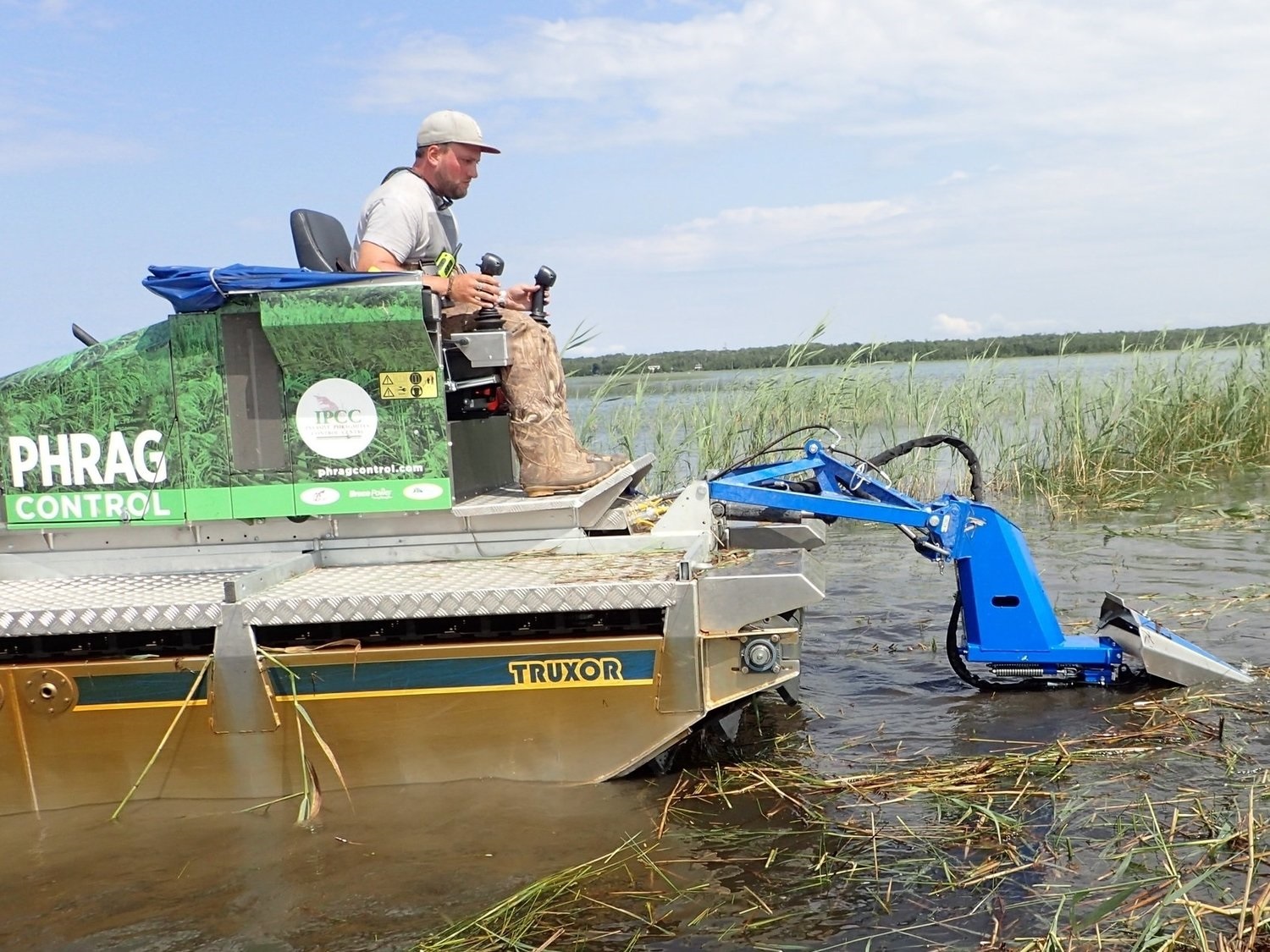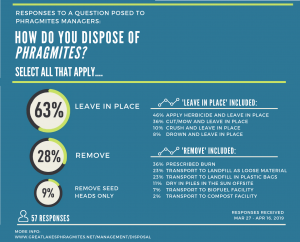Disposal
 What are the best methods for disposing of Phragmites biomass after treatment?
What are the best methods for disposing of Phragmites biomass after treatment?
Leaving standing dead Phragmites stems shades the soil and creates a physical barrier which makes the environment less suitable for colonization and regrowth of desirable plants. Leaving standing dead stems can also make herbicide application less effective. Proper disposal of remaining Phragmites biomass helps reduce the need for future management by preventing reestablishment and spread to adjacent properties through seed dispersal and vegetative growth.
The available options for transportation and disposal of Phragmites biomass are often dependent on local municipalities’ ordinances and rules. The GLPC recommends contacting your local municipality or invasive species organization to help determine what disposal option would be best for your site and treatment methods. Note that composting Phragmites is generally not recommended due to the potential for growth from rhizomes and seeds if high compost temperatures are not maintained.
View a summary of techniques below to learn more about post-management Phragmites biomass clean up and removal. Is there a method you use that isn’t listed here? Please let us know and we will add it to the site!
Preparation For Disposal
Preparation for Phragmites disposal involves gathering biomass from the growing location post-treatment. If gathering Phragmites after herbicide treatment, take proper protective measures since residual herbicide can be present up to 27 days post treatment (Sesin et al., 2019). See the management techniques webpage for more information on mechanical control and cutting Phragmites.
Methods for gathering and removing Phragmites are dependent on the size of the stand and hydrology of the site:
On land: For larger sites with stable ground, it may be beneficial to utilize tractors, backhoes, and other mechanical equipment that can collect Phragmites into piles and prepare it for disposal.
In water: For wetland sites or sites with standing water, stems, and other plant material should be moved to land for disposal. To prevent Phragmites biomass from dispersing from the site in standing water, stems should be collected as they are cut and piled into a barge or boat. Alternatively, the use of a floating boom/barrier can assist in preventing stems and plant debris from floating away. Use of other semi-aquatic large equipment (e.g., Truxor, Marshmaster, etc.) may be helpful to traverse wet areas and gather the cut reeds.
Resources:
- Video of a semi-aquatic vehicle used to gather Phragmites
- Sesin V., C.M. Davy, M.E. Dorken, J.M. Gilbert and J.R. Freeland. 2020. Variation in glyphosate effects and accumulation in emergent macrophytes. Management of Biological Invasions 11.

Piling After Cutting
Phragmites spreads primarily vegetatively via rhizomes/stolons but also produces seeds. To reduce risk of reestablishment from seed when piling plants, it is recommended to cut plants prior to flowering. If seed heads are present, they can be removed separately and placed in trash bags for disposal while the rest of the biomass is piled. Care should be taken to place piles of cut Phragmites on dry land, out of windy areas, and out of locations where flooding may occur. When left high and dry, Phragmites is less likely to re-sprout.
Leaving the pile: Piling alone, or crushing and piling, can speed up decomposition of the leftover biomass. Placing a dark colored tarp over the pile may also aid in decomposition, prevent regrowth, and prevent spread of any seeds by wind. Any regrowth from a pile can be managed by hand pulling or backpack spraying; however, extended site monitoring may be necessary if using this disposal method.
Burning the pile: If appropriate for the site, these piled mounds can be burned during prescribed fire season, (click here to learn more about managing with fire) and always check with your local municipality to find out what your local burn requirements are and if you need a permit.
Resources:
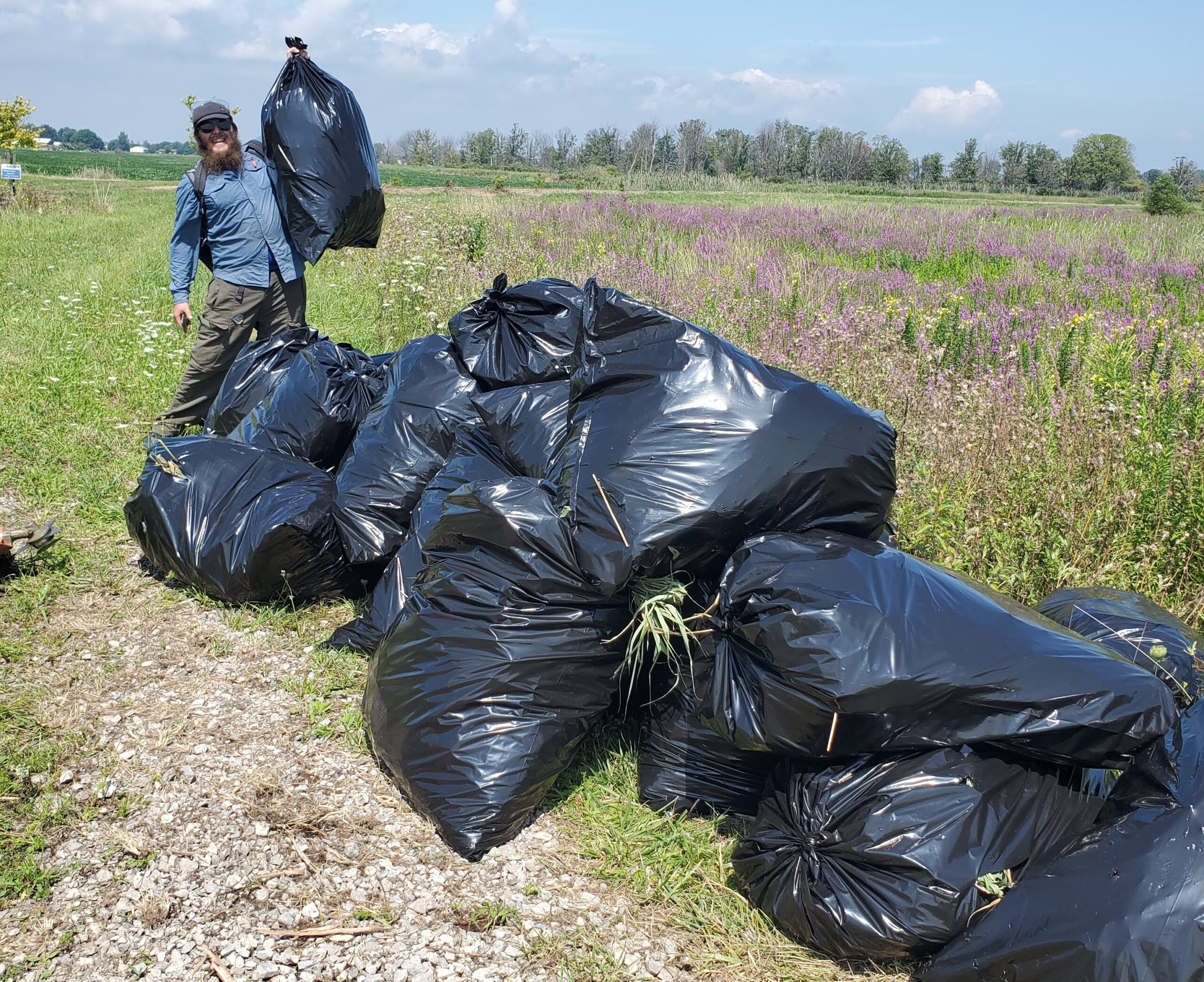
Bagging
Bagging Phragmites is more easily implemented for small stands where there is low overall biomass and even then, takes significant time and energy.
Cut stems can be packed into thick industrial trash bags, tied up, and left in a sunny location (“solarized”) until plant material is decayed and no longer viable, which can take up to several weeks. After checking that the plant material has sufficiently decayed, Phragmites can be left on site, buried, brought to municipal landfill, or burnt depending on local ordinances and what works best for the site. Alternatively, The Land Between recommends bagging only the seed heads in black plastic bags and allowing them to solarize, then using brown yard waste bags to collect and dry stems in preparation for burning.
Resources:
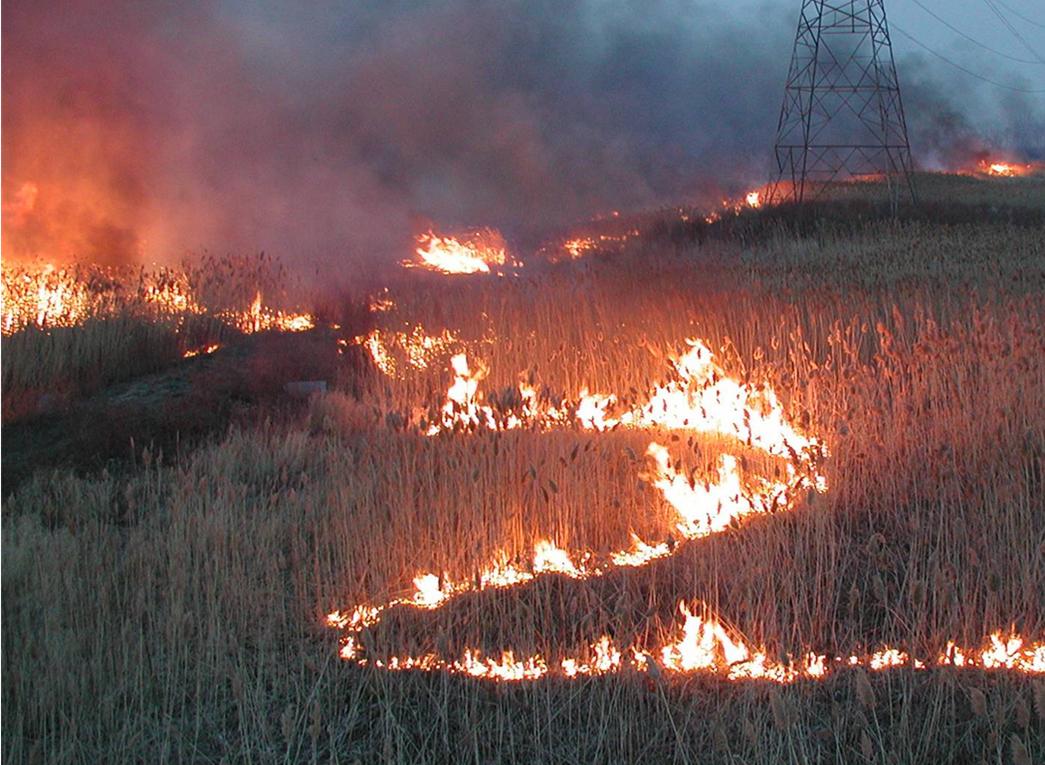
Burning stems in place
Burning dead Phragmites stems in place (without cutting and/or piling) is an effective and quick method to remove a large amount of biomass, clearing the soil surface to allow for seed germination of other desirable plants. Some sites are better suited for burning than others; large thick stands may result in unwieldy burns and sparse sites may not burn as well. Burning can be combined with other Phragmites disposal methods depending on site conditions and management goals (e.g., piling then burning, bagging then burning).
Burning non-native Phragmites creates a hot and smoky fire that produces greenhouse gas emissions and particulate matter. As a result, some places do not allow burning of Phragmites stands by law or ordinance. Special equipment, extensive training and a permit are all typically required to complete the work. Always check with your local municipality to find out what your local burn requirements are. Flattening the stems before burning may help maintain safe flame and smoke conditions. View management techniques to learn more about the pros and cons of prescribed fire use to manage Phragmites and if it would be beneficial for biomass removal at your site.
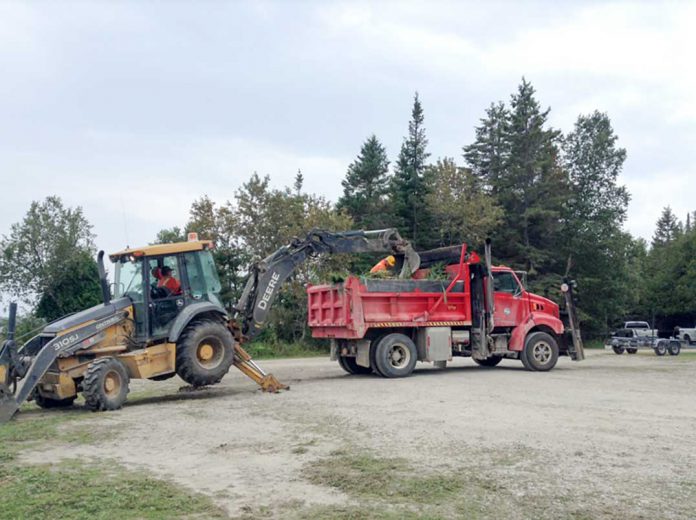
Burying Phragmites
To effectively bury Phragmites, cover with at least 1 meter of dry soil (Howell, 2017).
This method may only be feasible or practical during large-scale excavation projects using heavy equipment. Nearby municipal landfills may also bury mounds without additional cost; however, some may not accept Phragmites biomass. Contact your local landfill in advance to find out about disposal options. If Phragmites has already set seed, care should be taken to prevent composting of biomass in a landfill, and for isolation of materials away from windy areas if plant materials will not be immediately buried.
Resources:
- Howell, G.M.B. 2017. Best Management Practices for Invasive Phragmites M.S. Thesis, Waterloo, Ontario. Link.
Results: Phragmites disposal questionnaire
How are managers in the Great Lakes region disposing of Phragmites after treatment? In spring 2019, we sent this question to the Phragmitesnet listserv. Of the 57 responses received, 63% reported that they leave Phragmites in place, while 28% removed it from the site, and 9% removed seed heads only.
Additional resources
- Invasive Phragmites Best Management Practices in Ontario
- University of New Hampshire’s Methods for Disposing Non-Native Invasive Plants
- Florida Exotic Pest Plant Council’s Guidelines for Disposal of Terrestrial Invasive Plants
- New York State Guidelines for Disposing of Invasive Plant Material
- Michigan Citizen’s Guide to Invasive Plant Disposal

